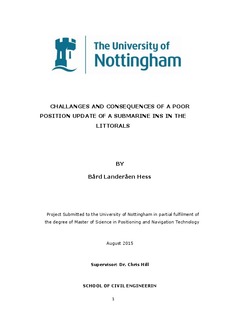| dc.description.abstract | There are two main success criteria’s within Submarine operations; Safe navigation and the ability to stay undetected.
A Submarine must be able to solve a wide range of operations, from peacetime engagements to war-scenarios. In order to conduct all types of operations the demand for precise navigation is high.
In addition to navigation, does the positioning system also updates the Command & Control- and weapon system.
The employment of both Submarines and surface ships are affected by the physical environment and weather conditions. Operating in a deep open ocean poses different challenges then operating close to shore, or in the littorals.
The high accuracy requirements combined with the need for covered submerged operations is a challenge when it comes to design of the Navigation systems for Submarines. As surface ships have a continued GNSS access, the Submarines does not. There are several techniques and modes of navigating a Submarine submerged (Terrestrial, optical (periscope), use of depth counters, Navigation Sonar etc). However, Dead reckoning by an accurate INS (Inertial Navigation System) is the main navigation method. The INS provides high bandwidth and precision attitude, with sensor quality varying with the size of the submarine and mission length.
The Submarine might be forced to go deep before a proper GNSS fix is obtained. There are mainly two reasons for this: Either to stay undetected (Tactical issue), or in order to avoid a collision (Safety issue). In these cases there will be an inaccurate update of the INS.
The study aims at determining the challenges and consequences of a poor position update of a Submarine INS in the littorals. For this purpose, analyses have been conducted in Inertial Explorer and Excel.
Comparing the position accuracy of different manipulated position updates showed that both different standard errors and position errors affects the performance of the INS/IMU. Some of the trials showed the multipath sometimes have a positive effect on the absolute accuracy.
The INS/IMU complies well with GNSS-updates, even with a few epochs
The analysis showed that it is challenging to the INS/IMU to navigate for long periods without GNSS-input, what is the case for a Submarine. | nb_NO |
